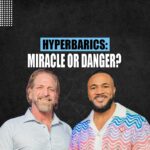When Dr. Joseph Dituri, better known as Dr. Deep Sea, joins a conversation, you’re not just listening to a scientist. You’re listening to a Navy veteran, a world-record holder who lived 100 consecutive days underwater, a professor, a biomedical engineer, and a man whose greatest medical breakthroughs were born from tragedy he experienced firsthand.
On a recent episode of “A Healthy Point of View, podcast, host Sam Tejada, CEO and Founder of Liquivida®, sits down with Dr. Dituri to explore the science and personal journey behind his groundbreaking work in traumatic brain injury (TBI), hyperbaric oxygen therapy, clinical research at USF, and the urgent need to reform how we treat the brain.
Dr. Joseph “Deep Sea” Dituri Lived 100 Days Underwater Reveals What Really Heals the Brain | Ep. 106

A Life Forged Under Pressure
Dituri’s story begins long before the lab and the accolades. Raised on Long Island, New York, he grew up with a working-class upbringing before joining the U.S. Navy. That decision set him on a path that would define the next 28 years of his life.
During his military service, he earned degrees all the way to a PhD in biomedical engineering. But the nickname “Dr. Deep Sea” came from his days as a diver, first as a friendly moniker between divers, then as a brand that would later become known worldwide.
In 2023, Dituri spent 100 days underwater, breaking the world record for the longest time anyone has lived submerged. While the world celebrated the stunt, it wasn’t a stunt at all; it was science. Dituri wanted to study how the body responds to long-term underwater environments, high pressure, and oxygen saturation.
This expertise, engineering mindset, and relentless curiosity would become crucial when his life took an unexpected turn.
The Accident That Changed Everything
Dituri didn’t enter TBI research solely as a scientist; he entered as a patient.
One day, while driving his beloved 1947 Chevy, his vehicle was T-boned by a large SUV at high speed. The impact left him unconscious with:
- A hemorrhagic stroke in the prefrontal cortex,
- Hospitalization in the ICU, and
- Memory and cognitive challenges that left him unable to recognize people around him.
But the treatment plan the doctors presented shocked him: “Don’t worry, all you need is a tincture of time.”
No immediate intervention. No therapeutic recovery plan. Just wait and hope.
Dituri refused. As a brain researcher, he already knew what few patients are told within 72 hours of a head injury, brain swelling and long-term damage can worsen dramatically if untreated.
The lack of a meaningful standard for TBI recovery lit a fire in him: “We’ve been documenting traumatic brain injury for thousands of years, and we still don’t have a clinical endpoint for what ‘cured’ is.” So he decided to design one himself.
Healing Himself, Then Thousands of Others
Dituri began using a protocol based on:
- Hyperbaric oxygen therapy,
- Diet and gut health improvement,
- Meditation and mental hygiene,
- Breath training,
- Sleep optimization,
- And incremental physical conditioning.
He healed not just to baseline, but stronger than before. So he began applying this protocol to others.
He started with two patients, one military veteran and one former football player. Within a month, both saw radical changes. They referred more patients, word spread, and the outcomes were staggering.
“I treated 19 people, and 100% showed major improvements. I received letters from their children saying, ‘Thank you for giving me my daddy back.’”
These results led to Dituri eventually becoming a leading clinical researcher in TBI recovery at the University of South Florida, where he now works to provide future soldiers with a real fighting chance, not just on the battlefield, but afterward.
Why the System Has Failed Brain Patients
The problem with TBI treatment isn’t lack of suffering; it’s lack of measurement and urgency.
The statistics are chilling:
- Football players experience 3–5 impacts per game at 35 mph, many leading to long-term neurological degeneration.
- Veterans suffer TBIs and PTSD at staggering rates, with inadequate standard care.
- 23–25% of head injuries in the U.S. come from domestic abuse, a nearly invisible epidemic.
Yet when the FDA reviewed Dituri’s clinical submission, they admitted that there isn’t even a universal definition for when a brain injury is officially “cured.”
Hyperbaric Oxygen: Not a Miracle But a Missing Tool
Hyperbaric oxygen therapy (HBOT) has become a major pillar of Dituri’s work—not as a cure, but as a catalyst for recovery.
Inside a chamber, patients breathe high-pressure oxygen, a therapy that:
- Increases cerebral blood flow
- Stimulates neurogenesis (new neuron growth)
- Triggers angiogenesis (new blood vessels)
- Boosts stem cell production (up to 8x in some studies)
- Reduces inflammation and swelling
It supports the body’s natural healing:
“Hyperbaric oxygen doesn’t cure anything. It puts your body in the right position to heal itself.”
However, Dituri warns that HBOT is in danger not scientifically, but commercially. Untrained operators, cheap home chambers, and misuse threaten industry credibility: “This is medicine. Oxygen under pressure is classified as a drug. It must be prescribed and administered responsibly.”
Without standards, he fears one high-profile accident could provoke federal shutdowns that prevent millions from getting access to a therapy that could help them.
Preparing Soldiers for an Unfair Fight
At USF, Dituri is now leading veteran-focused clinical research aimed at advancing “next-generation military medicine.”
One experiment is deceptively simple: If soldiers increase carbon dioxide in the bloodstream before combat like breathing in and out of a paper bag the resulting vasodilation increases cerebral blood flow, which may reduce the severity of TBI during an explosion or impact.
“These are simple, cheap, effective tools that could help protect our men and women. They deserve every advantage before going into harm’s way.”
It’s Not One Thing It’s Everything
While hyperbaric therapy is powerful, Dituri emphasizes that healing doesn’t come from a single treatment but from total biological alignment.
He uses the acronym GAMTHS:
G – Gym: Move your body.
A – Autophagy: Challenge your system to eliminate weak cells.
M – Mind: Meditation, prayer, faith connect to something greater.
T – Telomeres: Strengthen the cellular caps that control lifespan.
H – Hydration: Many people are just dehydrated, not fatigued.
S – Sleep: The brain heals and organizes itself during rest.
This whole-body foundation builds resiliency before a patient ever steps into a chamber.
The Emotional Side of Traumatic Brain Injury
Many patients don’t realize they’re changing, but their families do.
Dituri describes the heartbreak:
- Former athletes who go from strong leaders to men who can’t text, control emotions, or perform basic memory tasks.
- Veterans who look fine on the outside while internally battling confusion, anger, and despair.
- Spouses and children who watch loved ones become different people overnight.
TBI doesn’t just injure the patient; it injures the household.
Where Dr. Deep Sea Goes From Here
Dituri’s upcoming book chronicles his journey, clinical methodology, and the lives transformed along the way.
His mission is simple:
- Stop waiting for time to heal what the body could heal actively.
- Give patients care grounded in science not guesswork.
- Push medicine into a future where brain recovery has standards, protocols, and predictable outcomes.
- Give soldiers, athletes, accident victims, and unseen sufferers their lives back.
He ends with a final reminder: “Your body wants to heal. Give it the right tools and it will.”

